Directions: Read the given information carefully and answer the given question.
Representatives of the G-8 nations S, T, U, V, W, X, Y and Z are sitting around a circular table at equal distances but not necessarily in the same order. Some of them are facing the centre while some of them are facing outside (i.e. opposite to the centre). G-8 nations are United States (U.S.), United Kingdom (U.K.), Canada, Italy, France, Russia, Germany and Japan.
Representative of United States is facing the centre. V is sitting second to the right of W. Either both X and Z are facing the centre or both are facing outwards. Neither the representative of Germany nor the representative of Japan is the immediate neighbour of the representative of United States. X and T are immediate neighbours and none of them is the representative of Japan. Z is sitting second to the left of S, who is facing inwards. Y is sitting third to the left of the representative of Canada. Representative of Russia is sitting third to the right of Z. Either both U and T are facing the centre or both are facing outwards. S is either the representative of France or United States. Immediate neighbours of the representative of Russia are the representatives of Italy and United Kingdom. V is not the representative of Japan and is facing the centre. U is sitting third to the left of the representative of Japan and he is not the representative of United Kingdom. Representative of Italy is sitting fourth to the right of the representative of Canada. Representative of Japan is not next to the representative of France. None of the immediate neighbours of U is facing the centre. Representative of United Kingdom is facing the centre.
Representatives of the G-8 nations S, T, U, V, W, X, Y and Z are sitting around a circular table at equal distances but not necessarily in the same order. Some of them are facing the centre while some of them are facing outside (i.e. opposite to the centre). G-8 nations are United States (U.S.), United Kingdom (U.K.), Canada, Italy, France, Russia, Germany and Japan.
Representative of United States is facing the centre. V is sitting second to the right of W. Either both X and Z are facing the centre or both are facing outwards. Neither the representative of Germany nor the representative of Japan is the immediate neighbour of the representative of United States. X and T are immediate neighbours and none of them is the representative of Japan. Z is sitting second to the left of S, who is facing inwards. Y is sitting third to the left of the representative of Canada. Representative of Russia is sitting third to the right of Z. Either both U and T are facing the centre or both are facing outwards. S is either the representative of France or United States. Immediate neighbours of the representative of Russia are the representatives of Italy and United Kingdom. V is not the representative of Japan and is facing the centre. U is sitting third to the left of the representative of Japan and he is not the representative of United Kingdom. Representative of Italy is sitting fourth to the right of the representative of Canada. Representative of Japan is not next to the representative of France. None of the immediate neighbours of U is facing the centre. Representative of United Kingdom is facing the centre.
Solution
(1) From 'Z is sitting second to the left of S, who is facing inwards. Representative of Russia is sitting third to the right of Z. Immediate neighbours of the representative of Russia are the representatives of Italy and United Kingdom' we get two possibilities:
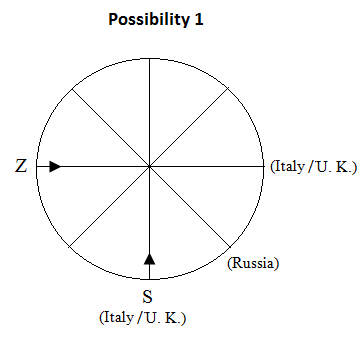
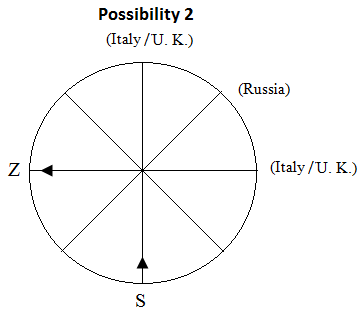
(2) Now from 'S is either the representative of France or United States' possibility 1 will be eliminated. Also from 'Representative of United Kingdom is facing the centre. Representative of Italy is sitting fourth to the right of the representative of Canada' we get the following information and also position of the person belongs to Italy get fixed.
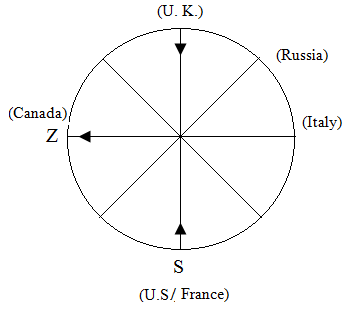
(3) Moving further from 'Y is sitting third to the left of the representative of Canada. Neither the representative of Germany nor the representative of Japan is the immediate neighbour of the representative of United States. U is sitting third to the left of the representative of Japan and he is not the representative of United Kingdom. Representative of Japan is not next to the representative of France. X and T are immediate neighbours and none of them is the representative of Japan. V is sitting second to the right of W. V is not the representative of Japan and is facing the centre' we get:
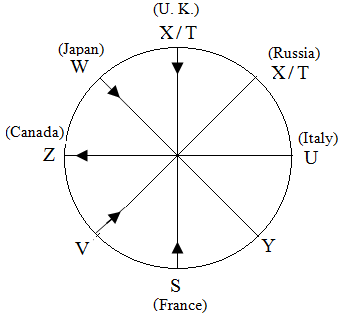
(4) At last from from 'Either both X and Z are facing the centre or both are facing outwards' we get that X is facing outwards and he belongs to Russia. Now from 'Either both U and T are facing the centre or both are facing outwards' we get U is facing inwards. From 'None of the immediate neighbours of U is facing the centre. Representative of United States is facing the centre' we get the final result as follows:
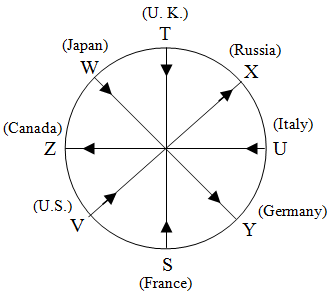
The representative of Russia is sitting second to the left of the representative of Germany.


(2) Now from 'S is either the representative of France or United States' possibility 1 will be eliminated. Also from 'Representative of United Kingdom is facing the centre. Representative of Italy is sitting fourth to the right of the representative of Canada' we get the following information and also position of the person belongs to Italy get fixed.

(3) Moving further from 'Y is sitting third to the left of the representative of Canada. Neither the representative of Germany nor the representative of Japan is the immediate neighbour of the representative of United States. U is sitting third to the left of the representative of Japan and he is not the representative of United Kingdom. Representative of Japan is not next to the representative of France. X and T are immediate neighbours and none of them is the representative of Japan. V is sitting second to the right of W. V is not the representative of Japan and is facing the centre' we get:

(4) At last from from 'Either both X and Z are facing the centre or both are facing outwards' we get that X is facing outwards and he belongs to Russia. Now from 'Either both U and T are facing the centre or both are facing outwards' we get U is facing inwards. From 'None of the immediate neighbours of U is facing the centre. Representative of United States is facing the centre' we get the final result as follows:

The representative of Russia is sitting second to the left of the representative of Germany.


Post a Comment